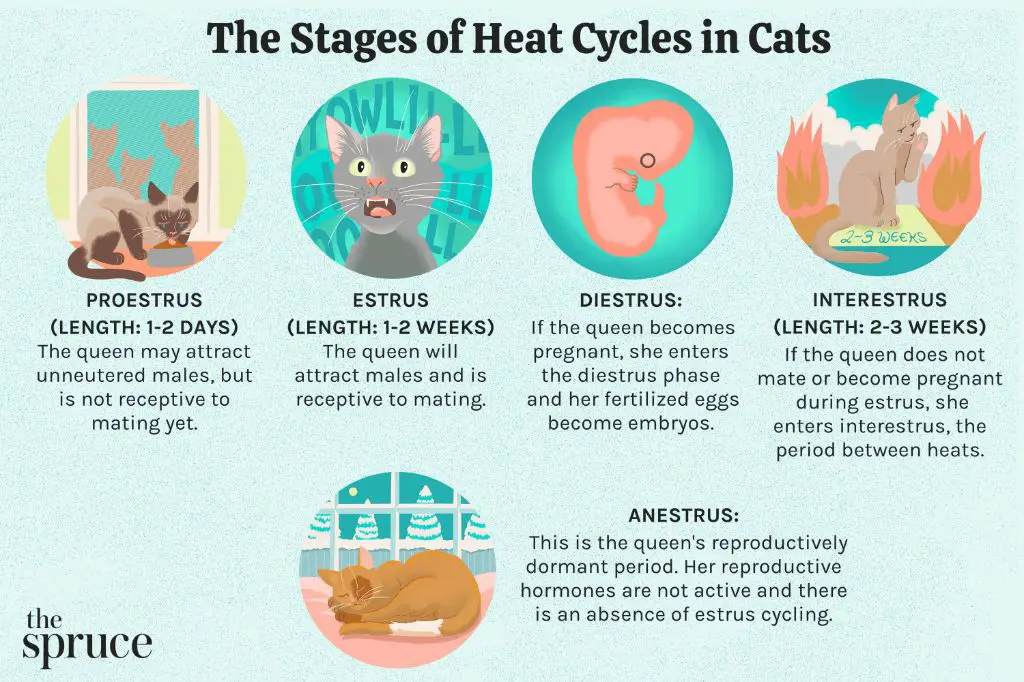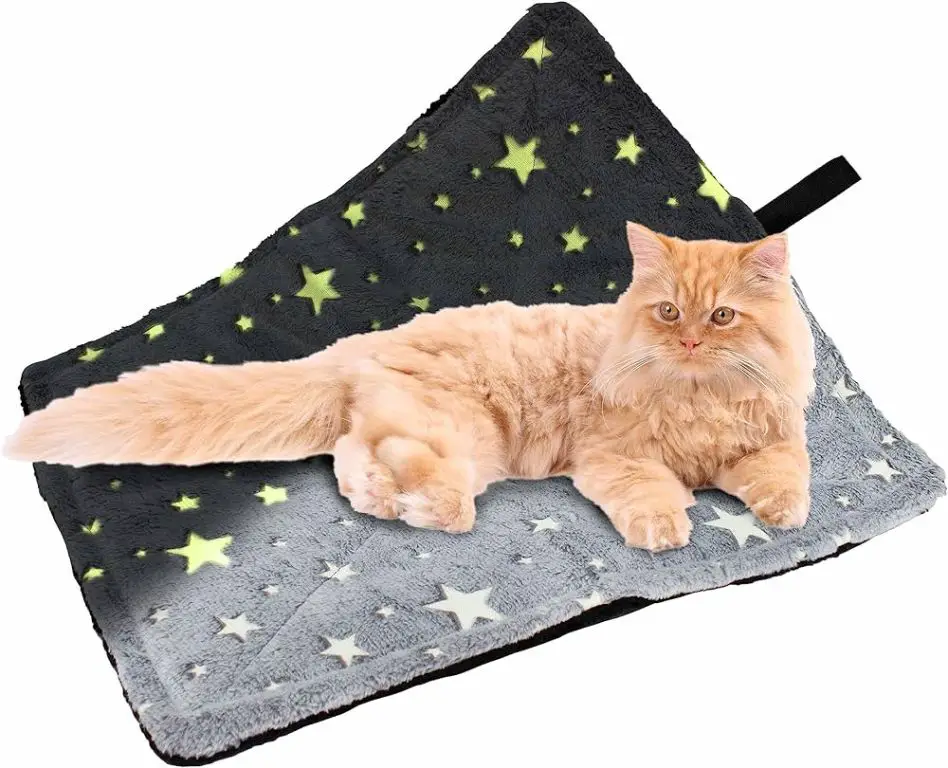It’s common for cat owners to hear their female cats making loud, distressed-sounding noises when they go into heat. These vocalizations can make it seem like the cat is in pain or discomfort. However, while being in heat causes behavioral changes, it is a natural part of a healthy cat’s reproductive cycle and not inherently painful.
Understanding the signs of feline estrus and knowing what to expect can help cat owners determine if their pet is actually in distress or just exhibiting normal heat behaviors. This knowledge enables owners to better care for an intact female cat during this time. Additionally, for those considering spaying, it provides context for evaluating the pros and cons of neutering cats to prevent recurrent estrus cycles.
The Feline Estrous Cycle
The feline estrous cycle is the reproductive cycle of unspayed female cats. It is also referred to as a cat’s “heat” cycle. The estrous cycle consists of four distinct phases: proestrus, estrus, interestrus, and anestrus (Johnson, 2022).
Proestrus is the first stage when estrogen levels begin to rise in preparation for estrus. This phase lasts around 1-2 days. The cat’s behavior may begin to change as she becomes more affectionate, vocal, and restless (VCA Hospitals).

Estrus is the breeding stage and usually lasts 4-10 days. The cat is receptive to mating during this time. She will display behaviors meant to attract male cats, like increased vocalization, rubbing, rolling, and raising her hindquarters (Little, 2012). This is the phase most people refer to as a cat being “in heat.”
Interestrus follows estrus and can last 20-50 days. Hormone levels return to normal during this rest period. The queen is no longer receptive to mating.
Finally, anestrus is a period of reproductive quiescence. This phase can last 80-90 days before the cycle starts again (Johnson, 2022). The entire estrous cycle lasts 2-3 weeks on average and recurs every 2-3 weeks until the cat is bred or spayed.
Signs of a Cat in Heat
There are several behavioral changes that indicate when a cat is in heat or estrus. According to My Pet & I, the most noticeable sign is increased vocalization. A cat in heat may wail, moan, or meow more persistently and loudly than normal. She is trying to attract potential mates.
A cat in heat also becomes more affectionate and restless. She may rub against people and objects more than usual. She may roll around on the floor frequently. Her restlessness stems from the urge to mate. A cat in heat will attempt to escape the house to search for a mate.
Other signs include holding the tail to one side, kneeling with hindquarters raised, and treading the back legs while keeping the front part of the body flat on the ground. These postures signal to males that she is receptive to mating. Her appetite may decrease as the desire to mate takes priority.
Is a Cat in Discomfort During Heat?
While cats in heat may seem agitated and vocalize more than usual, research indicates that they do not experience significant physical discomfort or pain during this time. According to veterinarians, the behavioral changes seen in cats in heat are driven by frustration, not by being in physical distress.
As noted by Dr. Gary Richter, veterinary health expert, “The simple answer is no, being in heat is not painful for cats, though they feel frustrated…The classic signs we associate with a cat in heat—the constant yowling and rubbing/rolling—are not signs of pain, just signs of frustration.” (Source)
The vocalizations, affectionate behavior, and restlessness exhibited by a cat in heat are indicators that she wants to find a mate and reproduce. Her hormones drive these behavioral changes. While she may seem uncomfortable to us humans, she is not thought to be in significant pain or distress. Her behavior is driven by a biological urge to mate and have kittens.
According to veterinarian Dr. Ivana Crnec, “From a medical standpoint, being in heat is not painful for female cats. However, it is extremely unpleasant and very frustrating.” (Source) So while not physically painful, the experience of being in heat creates agitation for cats.
In summary, research indicates that cats do not suffer physical pain when in heat, but they do experience frustration, agitation and urgency around their biological drive to reproduce. Their behaviors are signs of this urge to mate, not of being in distress or discomfort.
Possible Sources of Discomfort
If a cat does experience discomfort when in heat, there are a few potential sources:
Hormonal fluctuations – The increase in estrogen levels that triggers a heat can cause mood changes, restlessness, and vocalizing in cats. These hormone fluctuations may result in mild discomfort.

Uterine contractions – During heat, the uterus contracts in preparation for pregnancy. These contractions may be mildly painful or uncomfortable for some cats.
Vulvar swelling – Increased blood flow to the vulva causes it to become swollen. This swelling can sometimes cause irritation, itching, or discomfort.
Mating attempts – The pressure and activity of mating from male cats may cause soreness or irritation. Repeated mating attempts during heat can increase discomfort.
According to Are Cats in Pain When in Heat?, while individual cats may experience some mild discomfort from these sources, heat cycles are not typically described as being overtly painful for most cats.
Minimizing Discomfort
While cats in heat may experience some discomfort, there are steps owners can take to help minimize it:
Provide extra attention and affection during this time, including petting, brushing, and playing with interactive toys. The pheromone diffuser Feliway can also help relieve stress.
Make sure she has access to her normal hiding spots and quiet places to retreat when needed. Offer a softly heated pet bed for comfort.
Consider keeping intact male cats away during this time, as the presence of males can further stimulate the female cat.
Speak to your veterinarian about over-the-counter supplements that may help soothe cats in heat. There are some calming treats and sprays available.
Monitor your cat closely for signs of physical distress requiring medical attention. Seek veterinary advice if she stops eating, cries excessively, or seems depressed.
While you cannot stop the heat cycle itself, with some extra care and attention you can help minimize any discomfort for your cat.
When to See the Vet
Most signs of heat in cats are normal, but there are some warning signs that could indicate a medical issue requiring veterinary attention. These include:

- Excessive vocalization or anxiety
- Loss of appetite or refusal to eat
- Lethargy, weakness, or depression
- Vaginal discharge that is green, yellow, bloody, or foul-smelling
- Straining or difficulty urinating
- Fever
While cats in heat may seem more restless, needy, or vocal than usual, any severe behavior changes, signs of illness, or problems urinating warrant a visit to the vet. It’s important to rule out issues like uterine infection (pyometra), cystitis, or other conditions requiring treatment.
If your cat’s heat cycles seem overly frequent, prolonged, or difficult, discuss this with your veterinarian as well. They can advise on options for relieving your cat’s discomfort and regulating her cycles, such as hormone therapy or spay surgery.
See your vet promptly if your intact female cat exhibits concerning symptoms during or after her heat. It’s better to be safe and have her examined, especially if this is her first heat cycle. With prompt veterinary attention, most issues related to estrus can be managed for your cat’s health and comfort.
Spaying to Prevent Heats
Spaying refers to the surgical removal of a female cat’s ovaries and uterus, which eliminates the ability to reproduce and go into heat. It’s generally recommended to get cats spayed before their first heat, which typically occurs between 5-9 months of age.
There are several reasons why spaying to prevent repeated estrous cycles is advised:
- Prevents the frustrations of a cat in heat – the constant yowling, restless behavior, and attempts to escape to find a mate.
- Eliminates the risk of pregnancy and birthing for the cat, which can be taxing on the body.
- Reduces the risk of pyometra, a potentially fatal uterine infection seen in intact cats.
- Decreases the chances of mammary cancer, since ovarian hormones influence tumor growth.[1]
- Curtails undesirable behaviors like urine marking, roaming, and aggression associated with the hormones of an intact cat.
The spay procedure involves making a small incision just below the belly button into the abdomen. The ovaries are located and the uterus and ovaries are surgically removed. The incisions are then sutured closed. It is usually done while the cat is under general anesthesia and takes less than an hour for an experienced veterinarian. Most cats recover quickly with minimal discomfort afterwards.
[1] https://www.preventivevet.com/cats/benefits-of-spaying-or-neutering-your-cat
Caring for an Intact Cat
If you choose not to spay your female cat, you’ll need to provide special care for her when she goes into heat. Here are some tips for caring for an intact female cat through her heat cycles:

- Separate her from any unneutered male cats during her heat, as she can become pregnant very easily. Male cats can sense a female in heat from great distances.
- Give her access to comfortable, soft bedding where she can nest. She may appreciate a secluded spot like a cat carrier with bedding.
- Consider giving her a heat pack, warm towel, or heating pad for comfort. This may help calm her.
- Gently brush or pet her more frequently to help soothe her.
- Make sure she has easy access to food, water, and litter at all times.
- Clean the litter box more frequently as she will urinate more.
- Expect vocalizing, restlessness, and other behavioral changes. Be patient and give her extra affection.
- Schedule vet visits to monitor for reproductive issues like pyometra.
While heat cycles can be demanding, taking steps to comfort your cat and prevent unwanted litters will help. Discuss options like spaying with your vet as well.
Summary
In summary, the feline estrous cycle, commonly referred to as a cat’s “heat”, occurs every 2-3 weeks in unspayed female cats. Signs that a cat is in heat include behaviors like vocalizing, rubbing, rolling, and raising their hindquarters. While cats do not experience the same severe cramping human females encounter during menstruation, they may experience some discomfort related to hormones, behavior changes, and physical symptoms.
Possible sources of discomfort include things like swollen and tender vulva, discomfort from increased activity and vocalizing, lack of appetite, and restless sleep patterns. As a caring owner, there are steps you can take to minimize your cat’s discomfort during her heat cycles. Ensuring she has a safe, comfortable space, keeping her inside, discouraging mating behaviors, and discussing spay options with your veterinarian can all help reduce any distress.
Though unpleasant for both owners and cats, the feline estrous cycle is natural. With some care and planning, you can help keep your cat as relaxed and comfortable as possible until she is ready for spaying. If you have concerns about abnormal pain, behavior changes, or other warning signs, be sure to consult your veterinarian.

